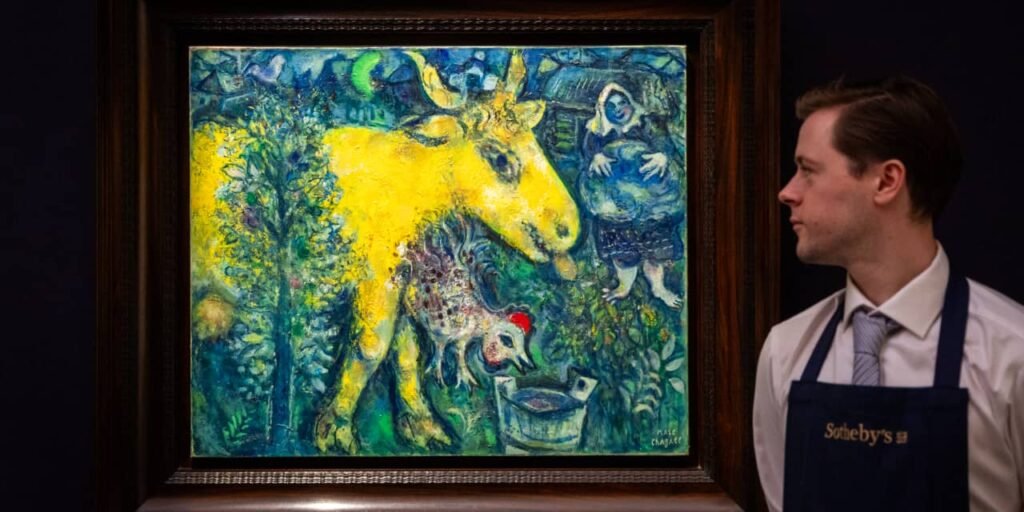Sotheby’s expanded into a new genre this week as its financial services arm offered US$700 million in securities backed by art-secured loans.
The transaction is not just a first for Sotheby’s, it also marks the first time loans backed by art and collectibles have been used to create securities. Institutional investors apparently clamored for the bonds as the deal was increased in size to US$700 million from an initially planned US$500 million.
The offering, which brings the total funding capacity of Sotheby’s Financial Services to US$2 billion, “will help further our mission of unlocking the power of our clients’ collections through the delivery of innovative financial solutions,” Ron Elimelekh, co-head of Sotheby’s Financial said in a news release on Wednesday.
The deal allows Sotheby’s to tap into a long-time strength—its dominance of the
global art-secured lending space, which was expected to reach between US$29 billion and US$34 billion last year, according to the latest Art Finance Report from Deloitte and ArtTactic.
Advertisement – Scroll to Continue
Competitors include Christie’s, but also a number of private banks and specialty asset-based lenders, such as New York-based Athena Art Finance and the Fine Art Group in London’s art finance unit. According to Sotheby’s, its financial services unit has originated more than US$10 billion in loans since it started three decades ago, with most of that activity concentrated in the last few years.
Art-secured lending involves enabling collectors to use their art as loan collateral. It’s a way to create liquidity out of an asset class that otherwise has none. Often the loans are backed by several works of art and collectibles; that diversification gives a lender more comfort in the ability of the borrower to repay.
The Sotheby’s deal, known formally as Sotheby’s ArtFi Master Trust, includes 89 loans that are secured by 2,484 works of fine art and collectibles, according to a presale document from Morningstar DBRS, which rated the transaction.
Advertisement – Scroll to Continue
The Sotheby’s deal is “certainly a landmark in some ways,” given it’s the first to include art-secured loans, says Doo-Sik Nam, a senior vice president for U.S. asset-backed securities credit ratings at Morningstar DBRS in New York.
But the structure is similar to many asset-backed securities, including those backed by credit-card loans or auto loans, Nam says.
Morningstar DBRS got comfortable with this particular structure because Sotheby’s Financial was able to provide it with “years and years of data tracking the performance of loans.” It also provided 10-plus years of auction data, detailing how it evaluates art and determines high and low estimates for individual works, Nam says. All loans are made against the low estimate.
Advertisement – Scroll to Continue
“By providing Sotheby’s actual auction results for art and collectibles that weren’t associated with loans, we were able to get a sense of how their historical valuations have compared to actual execution levels,” he says. “That’s across different types of art [and] different types of collateral or collectibles over a period of time.”
The rating analysts also went back through multiple economic cycles, including a corporate earnings recession from 2014-15, and the financial crisis of 2007-09. “What we found is that the performance has generally been fairly consistent,” Nam says.
According to the Deloitte and ArtTactic report, most clients take out art-secured loans to provide liquidity for their businesses, while many also use the loans to buy more art.
Advertisement – Scroll to Continue
Sotheby’s ArtFi Master Trust includes five classes of securities. The class A-1 notes, representing about 59% of the deal, are expected to receive the top triple-A rating from Morningstar DBRS. Those securities have the added protection of four subordinated classes with progressively lower ratings down to triple-B.
The transaction also includes a reserve class representing about 5.3% of the deal that is retained by Sotheby’s ArtFi Funding, which would absorb the first losses in the transaction should they occur. The final ratings will be set when the transaction closes on Tuesday.
The 89 loans backing these deals are on a range of art and collectibles. According to the presale document, 43% of the collateral is in contemporary art, 21% is in Old Master paintings, 15.57% is impressionist and modern art, 5.25% is Latin American impressionist, and 3.72% is Chinese works of art. Design, furniture, books, jewelry, watches, and wine and other luxury items that could be sold at Sotheby’s in a live auction, private sale, or online, may also be in the pool.
Advertisement – Scroll to Continue
More than 80% of the works are in storage, with 18.2% in a collector’s residence or office, and 1% in a museum or exhibition.
Investors in Sotheby’s ArtFi securities receive returns from quarterly interest paid on these loans and then, eventually, their repayment, which won’t begin until March 2026. At that point, they are expected to be amortized fairly quickly, Nam says.
Though other art lenders may want to follow in Sotheby’s footsteps, there is unlikely to be a big market for securities backed by art-secured loans. That’s because few lenders are in a position to have the expertise needed to evaluate the art and collectibles, and the historical data on how these assets perform, in addition to being familiar with the borrowers.
“There are a handful of other auction houses that may have that similar positioning and that expertise … but Sotheby’s is the dominant one and that’s how we got comfortable,” Nam says.






